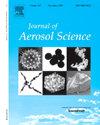Photophoretic forces in coated-hollow microspheres
IF 3.9
3区 环境科学与生态学
Q2 ENGINEERING, CHEMICAL
引用次数: 0
Abstract
Photophoresis is a phenomenon that generates thermally induced forces on microparticles immersed in a gas when exposed to a light beam such as a laser. Enhancing photophoretic forces depends on the alignment of the geometrical, thermal, and optical properties of the particles. The hypothesis explored here considers coated hollow microspheres to be a promising approach to this challenge. Therefore, we first present a photophoresis model for a three-layered microsphere in the slip-flow regime by applying Navier–Stokes equations with corrected boundary conditions. The numerical approaches used to compute the heat source function consider the Lorenz–Mie theory, and validate the results with those of previous studies. When applied to a copper-coated glass bubble, the model analyzes the photophoretic force as a function of the coating thickness considering several shell thicknesses. The results indicate that nanometric-scale coatings initially enhance the force to a maximum, beyond which the high thermal conductivity of copper leads to a reduction in the force. For coatings with thicknesses above nm, the force becomes insensitive to the shell thickness, demonstrating the dominance of copper in optical and thermal phenomena. Suppose that the fabrication of an optimal coating thickness cannot be precisely achieved. This study suggests depositing excess coating to ensure higher photophoretic forces, thereby providing a framework for optimizing the microparticle design in photophoretic applications. Future work will include validation through experiments and finding analytical solutions for integrals associated with internal heat generation using the Lorenz–Mie theory, which holds great promise for advancing our understanding of photophoresis.
求助全文
约1分钟内获得全文
求助全文
来源期刊

Journal of Aerosol Science
环境科学-工程:化工
CiteScore
8.80
自引率
8.90%
发文量
127
审稿时长
35 days
期刊介绍:
Founded in 1970, the Journal of Aerosol Science considers itself the prime vehicle for the publication of original work as well as reviews related to fundamental and applied aerosol research, as well as aerosol instrumentation. Its content is directed at scientists working in engineering disciplines, as well as physics, chemistry, and environmental sciences.
The editors welcome submissions of papers describing recent experimental, numerical, and theoretical research related to the following topics:
1. Fundamental Aerosol Science.
2. Applied Aerosol Science.
3. Instrumentation & Measurement Methods.
 求助内容:
求助内容: 应助结果提醒方式:
应助结果提醒方式:


